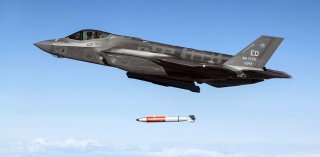The Only Thing More Formidable Than the F-35 Is a Nuclear-Armed F-35
The F-35 is one step closer to carrying nuclear bombs. What’s next?
The Pentagon, Department of Energy (DOE), and Air Force have taken a substantial step toward arming the now operational Lockheed Martin F-35A Lightning II stealth fighter with an upgraded, highly-capable nuclear bomb.
While formal nuclear certification of the new B61-Mod 12 make take a little time as it comes in operational and design phases, the DOE’s National Nuclear Security Administration is announcing that its first production unit of the B61-12 Life Extension Program has been successfully completed, launching a new sphere of airborne nuclear attack possibilities.
The weapon is a new variant of a nuclear bomb that first emerged in 1968, which includes increased safety and reliability along with a significantly streamlined mission envelope. The B61-12 consolidated the attack functionality of multiple previous B61s to include Mods 3, 4, 7, and 11. Each of these previous variants, which still exist, performs a specific attack function such as an earth-penetrating strike, low or high-yield attack, or area detonation capability. With the B61-12, all of these missions are integrated into a single, adjustable, or tailorable nuclear weapon. This allows aircraft to tailor specific effects and carry more bomb possibilities on a single attack mission.
Along with the F-35A, the weapon will arm the Northrup Grumman B-2 Spirit bomber and emerging new B-21 Raider stealth bomber, offering low-yield, high-yield, bunker buster, and above-ground “area” attacks in a single bomb for crews. It is by no means surprising that stealth bombers will operate with the weapon, but what would a nuclear-armed F-35 bring to a tactical equation in war?
There are certainly a number of variables to consider, as a high-speed, lower altitude maneuvering nuclear threat such as that presented by an F-35, would introduce new dilemmas for an enemy. Perhaps target information changes quickly or enemy assets are on the move? A maneuvering, lower-altitude yet nuclear-capable F-35 brings an ability to hold more targets at risk under a wider range of tactical contingencies. Perhaps Intercontinental Ballistic Missiles (ICBMs), which need to travel through space, are too easily detectable by enemy satellites and space sensors? Perhaps approaching ICBMs simply take too long as they need roughly twenty minutes in the mid-course phase to cross between continents in many cases? Perhaps an enemy has well-evolved missile defenses? Added to this, perhaps a high-altitude stealthy bomber is unable to reach a maneuvering target for a low-yield nuclear strike, or lacks the speed to fight off enemy air-and-ground attacks should it be detected?
An F-35 could not only help protect a B-2 or B-21 by countering enemy air defenses and airborne fighter jets, but also use its proximity to the ground and speed to hold otherwise unreachable targets at risk. An F-35, armed with a B61-12 capable of earth-penetrating nuclear strikes, might be able to release a highly precise and highly lethal low-yield targeted strike against enemy assets or facilities buried underground, without having to damage above-ground infrastructure.
Kris Osborn is a defense writer for the National Interest. Osborn previously served at the Pentagon as a Highly Qualified Expert with the Office of the Assistant Secretary of the Army—Acquisition, Logistics & Technology. Osborn has also worked as an anchor and on-air military specialist at national TV networks. He has appeared as a guest military expert on Fox News, MSNBC, The Military Channel, and The History Channel. He also has a Master’s Degree in Comparative Literature from Columbia University.
Image: U.S. DoD/F-35 Joint Program Office

